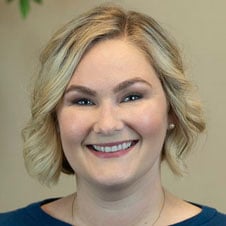In the past four years, four different labor-and-delivery units have closed across rural northern Minnesota. “It’s created this extreme shortage of places where women can receive obstetric services and gynecologic care,” said Johnna Nynas, MD, OB-GYN at Sanford Bemidji Medical Center.
Dr. Nynas is delivering babies while also extending her reach deep into the surrounding rural areas using telehealth for prenatal visits. With some patients driving more than two and a half hours to get to the medical center, offering video prenatal visits “just seemed liked the logical thing to do,” she added.
Based in Sioux Falls, South Dakota, Sanford Health had begun its Baby Beats program prior to the pandemic and its popularity continues to grow. Sanford Health is a member of the AMA Health System Program, which provides enterprise solutions to equip leadership, physicians and care teams with resources to help drive the future of medicine.
While the first pregnancy appointment must be in-person, patients are given home-monitoring kits that include a fetal doppler to monitor the baby’s heartbeat and a blood-pressure cuff. The video visits are conducted over the My Sanford Chart secure online connection that gives patients 24-hour access to their medical records, scheduling, prescription renewals and test results.
Any prenatal visit that does not require an on-site procedure such as labs or ultrasound can be safely done virtually. Patients who previously had to cancel office visits due to work, weather or transportation issues, can keep their appointments via video, Dr. Nynas said.
Supporting telehealth is an essential component of the AMA Recovery Plan for America’s Physicians.
Telehealth is critical to the future of health care, which is why the AMA continues to lead the charge to aggressively expand telehealth policy, research and resources to ensure physician practice sustainability and fair payment.
‘It’s been very exciting to see it grow’
In addition to offering OB video visits, Sanford Health launched a remote patient monitoring pilot using AI-enabled non-stress tests to monitor fetal heart rate and the presence of contractions for patients who may be at higher risk of pre-term delivery. Patients are given a non-stress test belt to use from the comfort of their home, and the data is transmitted in real-time to the clinic.
“We’re seeing better compliance with the recommended care and that contributes to better outcomes,” said Dr. Nynas. “It’s been very exciting to see it grow. My patients have been very open to doing this. A significant majority of my patients end up doing some kind of remote care at some time during their pregnancy.
“I woke up this morning and it was -20 with -35 windchill—weather is a factor where we live,” she added. “Patients also struggle financially. They may not have a reliable vehicle or money for gas, so when we bring the care to them and make it easier for them, they’re more likely to engage in their care.”
Patients helping patients
“There is a lot that can be done using these virtual technologies to help patients better understand their conditions and how to monitor them at home, and why it’s important,” said Dr. Nynas. “By showing them the skills and tools they need to monitor their health at home, I’m seeing that impacts women in other ways.”
Patients are taught what level of high blood pressure is considered dangerous and the next steps to take if it reaches that level—and patients are teaching this to their peers.
“Women are starting to educate each other in the community,” Dr. Nynas said.
This has led to women who weren’t Sanford patients coming to the health system’s emergency departments because they had learned the warning signs of preeclampsia from their friends who had learned them from Dr. Nynas.
“We're just at the tip of the iceberg of the potential impact that programs like this could have when we lean into them,” she said.
Local effort has regional impact
In-person office visits reveal “just a sliver” of a patient’s life. But video visits provide more of a whole picture of the patient’s life and environment.
“Sometimes that insight's been really helpful,” Dr. Nynas said. “We've identified some patients who needed to be connected with community resources as it pertains to those social determinants of health that we focus on so much in medicine now—things like inadequate housing and inadequate food.”
Dr. Nynas was instrumental in Sanford securing a $3.67 million grant from the U.S. Department of Health and Human Services’ Rural Maternity and Obstetric Management Strategies (RMOMS) program, which was used to build the Families First: Rural Maternity Health Collaborative.
The regional collaborative, which includes the Indian Health Service, county health departments, Sanford and other regional partners, is focused on improving access to prenatal, obstetric and postpartum care and reducing inequitable outcomes for women in rural, underserved and tribal communities.
“What we are doing is trying to break down those social determinants of health barriers that exist for women in our region with a specific emphasis on targeting those barriers that exist for Native American women,” Dr. Nynas said.
Native American women living in rural areas are twice as likely to receive late or no prenatal care and have double the rate of perinatal mortality as white women, according to a Sanford Health news release.
She explained that, while Native Americans make up only 2% of the U.S. population, in the area around Bemidji—located north of the Mississippi River’s headwaters—23% of the population is Native American.
“We needed to do something to take action and it seemed very clear that one of the initial first steps needed to be to break down the barriers to care,” Dr. Nynas said. “To do that, let's bring care to them.”




